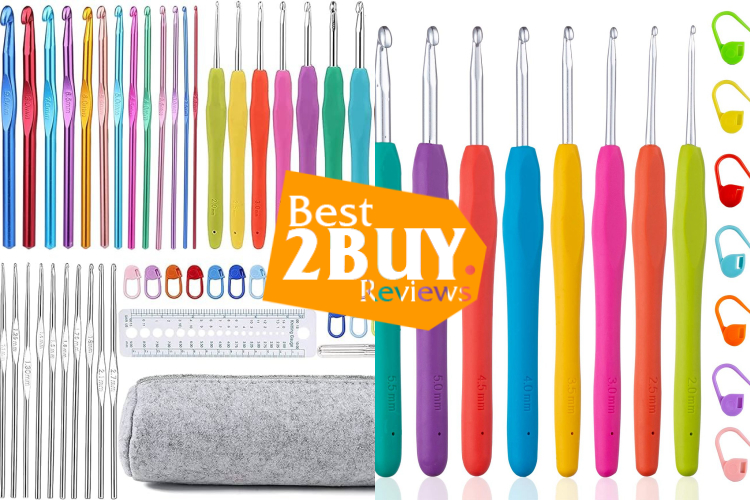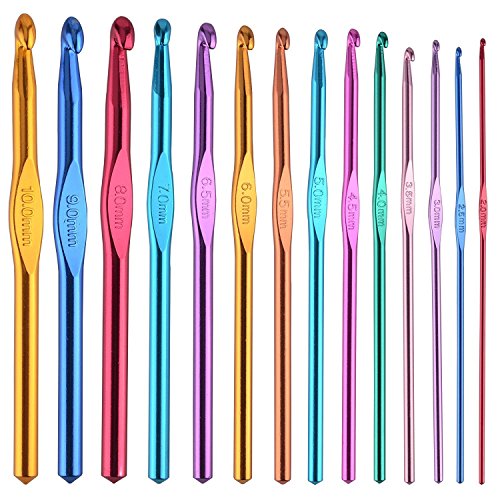Goodmorning my readers. I’m James Wilson from best2buy.reviews. Today, I will share you some information and give you some tips for choosing Crochet hooks. Let’s check it now!
- 1. Styles of Crochet Hooks
- 1.1. Tapered Hooks
- 1.2. Inline Hooks
- 1.3. Ergonomic Hooks
- 1.4. Steel Hooks
- 1.5. Afghan or Tunisian Hooks
- 1.6. Boye Hooks
- 1.7. Bamboo or Wood Hooks
- 1.8. Plastic Hooks
- 1.9. Interchangeable Crochet Hooks
- 2. Materials of Crochet Hooks
- 2.1. Aluminum
- 2.2. Steel
- 2.3. Plastic
- 2.4. Wooden
- 2.5. Bamboo
- 2.6. Ergonomic Materials
- 2.7. Acrylic
- 2.8. Glass
- 2.9. Bone and Horn
- 3. Purposes and benefits of Crochet Hooks
- 3.1. Purposes of Crochet Hooks:
- 3.1.1. Creating Stitches
- 3.1.2. Working with Yarn
- 3.1.3. Pattern Execution
- 3.1.4. Creating Fabric
- 3.1.5. Lace Crochet
- 3.1.6. Tunisian Crochet
- 3.2. Benefits of Crochet Hooks:
- 3.2.1. Creativity
- 3.2.2. Portability
- 3.2.3. Relaxation and Stress Relief
- 3.2.4. Hand-Eye Coordination
- 3.2.5. Functional and Decorative Items
- 3.2.6. Community and Social Interaction
- 3.2.7. Gifts and Self-Expression
- 3.1. Purposes of Crochet Hooks:
- 4. How to choose Crochet Hooks?
- 4.1. Consider the Yarn Weight:
- 4.2. Check the Pattern:
- 4.3. Consider the Project:
- 4.4. Try Different Materials:
- 4.5. Choose the Hook Style:
- 4.6. Test the Grip:
- 4.7. Try Before You Buy:
- 4.8. Build a Collection:
- 4.9. Consider Interchangeable Hooks:
- 5. In conclusion
Crochet hooks are essential tools used in the craft of crocheting. Crocheting is a textile art that involves creating fabric or items by interlocking loops of yarn, thread, or other fibers using a crochet hook. Crochet hooks are slender, pointed instruments with a curved or hook-shaped end, which allows crocheters to pull loops of yarn through other loops to create various stitches and patterns.

Styles of Crochet Hooks
Some common styles of crochet hooks:
Tapered Hooks
Tapered crochet hooks are the most traditional and widely used style. They have a gradually pointed tip, which makes it easier to insert the hook into the desired stitch. These hooks are versatile and work well for a wide range of crochet projects.
Inline Hooks
Inline crochet hooks have a more pronounced, inline, or straight shaft, which makes it easier to maintain consistent tension and even stitches. They have a less tapered throat compared to traditional hooks, resulting in a slightly different feel and stitch appearance.
Ergonomic Hooks
Ergonomic crochet hooks feature comfortable, cushioned handles designed to reduce hand and wrist strain during long crocheting sessions. These hooks are especially popular among crocheters with hand or wrist pain. The handle can be made from various materials, such as rubber or foam.
Steel Hooks
Steel crochet hooks are typically used for working with fine thread and creating delicate lace crochet projects. They are often very small in size, with a thin steel shaft and a tiny, rounded hook tip.
Afghan or Tunisian Hooks
Tunisian crochet, also known as Afghan crochet, uses an extended crochet hook with a stopper at the end. These hooks allow you to work on a larger number of stitches and create a fabric that is more akin to knitting in its appearance. Tunisian crochet hooks are longer than standard hooks.
Boye Hooks
Boye hooks have a unique shape, with a rounded tip and a slight taper, which some crocheters prefer for specific projects. They are often color-coded to help identify the size more easily.
Bamboo or Wood Hooks
Some crocheters prefer the feel of wooden or bamboo hooks, as they are lightweight and warm to the touch. These hooks are available in various styles, including tapered, inline, and ergonomic.
Plastic Hooks
Plastic crochet hooks are affordable and lightweight. They are often used by beginners and are suitable for a wide range of projects.
Interchangeable Crochet Hooks
Interchangeable crochet hooks consist of a handle and detachable hook tips. This allows crocheters to swap out different hook sizes for various projects. It's a versatile option for those who don't want to invest in a large collection of individual hooks.
Materials of Crochet Hooks
Some common materials used to make crochet hooks:
Aluminum
Aluminum crochet hooks are widely used and appreciated for their lightweight feel and smooth, metal texture. They glide easily through yarn and are available in a broad range of sizes. They are a good choice for various crochet projects.
Steel
Steel crochet hooks are primarily used for working with fine threads and creating delicate, intricate lace crochet projects. They are smaller and thinner than aluminum hooks and often come in numbered sizes rather than letter sizes.
Plastic
Plastic crochet hooks are affordable, lightweight, and ideal for beginners. They are available in a variety of colors and are easy to find. However, some crocheters prefer the feel of other materials because plastic hooks may have a slightly different texture.
Wooden
Wooden crochet hooks are favored for their warm and comfortable feel. They come in various wood types, such as bamboo, birch, and rosewood, each offering a unique aesthetic and texture. Wooden hooks can be a great choice for crocheters who want a more organic and tactile experience.
Bamboo
Bamboo crochet hooks are a subset of wooden hooks, and they are known for their lightweight and eco-friendly nature. The smooth surface of bamboo hooks allows yarn to slide easily without splitting.
Ergonomic Materials
Some crochet hooks are designed with ergonomic handles made from materials like rubber, foam, or silicone. These materials provide a comfortable grip and are suitable for crocheters who want to reduce hand strain during extended crocheting sessions.
Acrylic
Acrylic crochet hooks are less common but are available. They are lightweight and may be preferred by some crocheters.
Glass
Glass crochet hooks are less common and often used as decorative items or for specialty purposes. They provide a unique, transparent look and feel.
Bone and Horn
Crochet hooks made from bone or horn are rare but cherished by some crocheters for their smoothness and unique aesthetics. They can be more expensive and less readily available.
Purposes and benefits of Crochet Hooks
Purposes of Crochet Hooks:
Creating Stitches
The primary purpose of crochet hooks is to create different crochet stitches by pulling loops of yarn through other loops. This fundamental action forms the basis for various crochet patterns, designs, and projects.
Working with Yarn
Crochet hooks are designed to handle different types of yarn, thread, or fibers. They allow you to manipulate and shape the yarn into a wide range of patterns and textures, making them versatile tools for a variety of crochet projects.
Pattern Execution
Crochet hooks are crucial for following crochet patterns and instructions. The size and style of the hook you use can greatly influence the gauge and appearance of your work.
Creating Fabric
Crochet hooks are used to create fabric and items such as scarves, blankets, clothing, amigurumi, and decorative items. You can use them to make everything from functional items to works of art.
Lace Crochet
Crochet hooks are indispensable for delicate and intricate lace crochet projects, allowing for the creation of delicate and highly detailed lace patterns.
Tunisian Crochet
For Tunisian crochet, an extended version of crochet that creates a fabric resembling knitting, special hooks are used. These hooks have a longer shaft and a stopper at the end to accommodate the many loops needed for this technique.
Benefits of Crochet Hooks:
Creativity
Crochet hooks offer a creative outlet, allowing you to express yourself through colors, textures, and designs. You can customize your projects and create unique, one-of-a-kind items.
Portability
Crochet is a portable craft, and crochet hooks are compact, making it easy to take your projects with you on the go. This portability allows you to work on crochet wherever you have spare time.
Relaxation and Stress Relief
Crocheting can be a calming and meditative activity, offering relaxation and stress relief. The repetitive motions of crocheting can be soothing and help reduce anxiety.
Hand-Eye Coordination
Crocheting with hooks enhances hand-eye coordination and fine motor skills, making it a beneficial activity for individuals of all ages.
Functional and Decorative Items
Crochet hooks enable you to create functional items like warm scarves and cozy blankets, as well as decorative items such as amigurumi toys and intricate doilies.
Community and Social Interaction
Crocheting is often a social activity, allowing you to connect with others who share the same interest. You can join crochet groups, participate in workshops, and bond over your shared passion.
Gifts and Self-Expression
Crochet hooks provide a means to make personalized, handmade gifts for loved ones and express your creativity through your craft.
How to choose Crochet Hooks?
The steps to help you choose the right crochet hook:
Consider the Yarn Weight:
The weight of the yarn you plan to use is a primary factor in selecting a crochet hook. Heavier yarns (such as bulky or super bulky) require larger hooks, while lighter-weight yarns (like lace or fingering) require smaller hooks. Most yarn labels provide a recommended hook size range for the yarn.
Check the Pattern:
If you're following a crochet pattern, the designer may specify a recommended hook size. It's a good starting point to ensure your stitches match the pattern's gauge. If your gauge differs significantly from the pattern, your finished item may not turn out as expected.
Consider the Project:
Different projects may benefit from specific hook styles. For example, if you're making an intricate lace doily, you might prefer a steel hook, while an ergonomic hook may be more comfortable for a large blanket.
Try Different Materials:
Crochet hooks come in various materials, including aluminum, steel, plastic, wood, bamboo, and ergonomic options. Experiment with different materials to see which feels most comfortable in your hand. Some people prefer the smoothness of metal hooks, while others like the warmth of wooden or bamboo hooks.
Choose the Hook Style:
Decide on the hook style based on your preference and comfort. Tapered, inline, or ergonomic hooks are all viable options. Ergonomic hooks with cushioned handles can be especially beneficial if you have hand or wrist discomfort during extended crocheting sessions.
Test the Grip:
Hold the crochet hook and mimic the motion you use when crocheting. Make sure the grip feels comfortable and secure. The hook should fit comfortably in your hand, and you should be able to maintain good control while crocheting.
Try Before You Buy:
If possible, try out different hooks in a craft store or at a local crochet group. This hands-on experience can help you determine which hooks work best for you.
Build a Collection:
As you gain more experience, you may find it helpful to have a variety of hook sizes and materials in your collection. This allows you to be prepared for different projects and yarns.
Consider Interchangeable Hooks:
If you're an avid crocheter, you might consider investing in a set of interchangeable crochet hooks. These sets often include a range of hook sizes and styles that can be swapped onto a common handle, offering versatility and convenience.
In conclusion
Crochet hooks are an integral part of the crocheter's toolkit, and selecting the right hook for a project is crucial to achieving the desired results. Different patterns and yarns often specify which hook size to use to ensure that your stitches are consistent and your finished piece matches the intended dimensions and appearance.
If you want to buy Crochet hooks, check out websites. We noted top products which highly appreciated. You can refer and buy it in store or shopping online. If you buy online, check out Amazon as link, it’s very convenient. Hope you will find and satisfied with your selection.
If you need any further information, kindly comment below. I’m James Wilson, editor at best2buy.reviews. I’m very happy to answer your questions.











